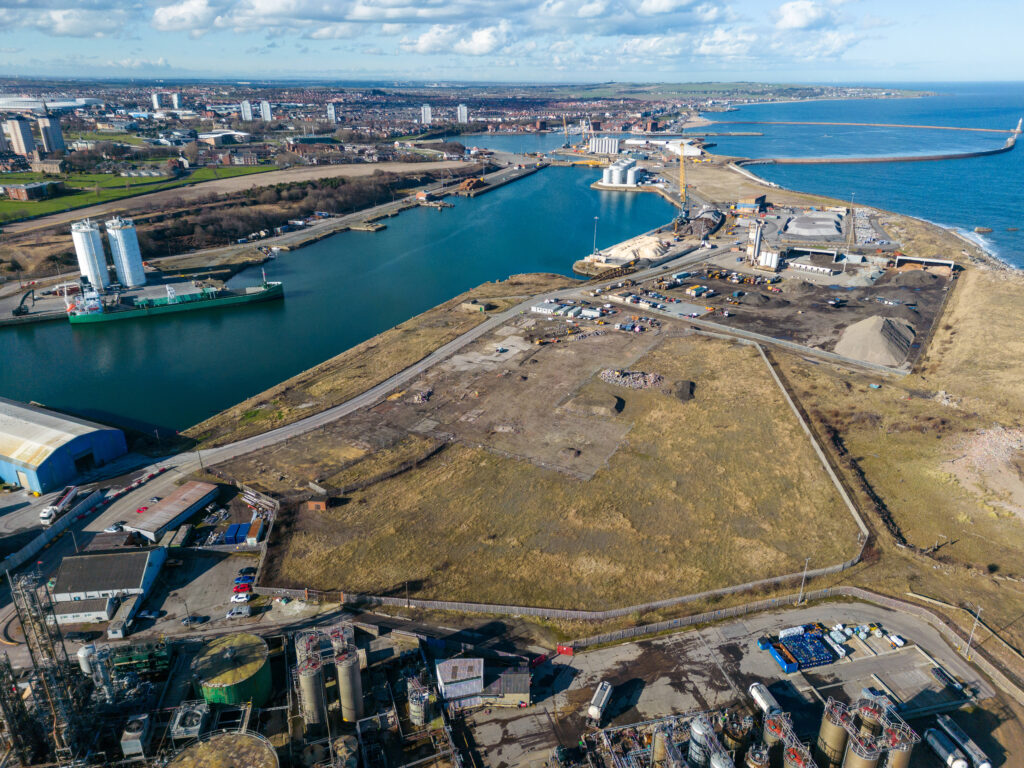A circular solution to simultaneously manage waste and produce cleaner fuels
Every year, billions of tyres are manufactured globally, and billions reach the end of their useful life. What happens to them? Are they recycled? The answer varies from country to country, but the picture is far from reassuring. Most of them are either landfilled or incinerated. Many are exported to countries where they are burned in unsafe conditions, posing serious environmental and health hazards. But what if this polluting waste could power aircraft instead of contaminating rivers and landfills? What about the possibility to reuse it and create a product with a low-cost process?
That’s the insight that sparked the idea of Christian Hvamstad. He was a Norwegian business student when he first arrived in Sunderland during school. He is now the co-founder, chief strategy officer and director of Wastefront AS, a Norwegian company established in 2019 to pursue this ambitious goal.
Sunderland: the port of innovation
The company’s first full-scale industrial plant is currently under construction in Sunderland, a coastal city in northeast England, just southeast of Newcastle upon Tyne. With a population of around 200,000, Sunderland may seem like an unlikely hub for green fuel innovation, but it is fast becoming just that. Backed by an estimated £100 million investment, Wastefront’s flagship facility is being built directly at the Port of Sunderland, on the River Wear. The company converted the historic River Wear Commissioners Building, a historic site linked to Sunderland’s shipbuilding heritage, as its headquarters.

The plant is expected to process up to 80,000 ton of end-of-life tyres annually, generating two main outputs: Sustainable Aviation Fuel (SAF) and also recovered carbon black, this one can be reused in new tyres or industrial applications. The project is being developed in close coordination with the local community, environmental regulators, and port authorities to deliver both local economic benefits and global environmental benefits.
The Wastefront plant in Sunderland: the first large!scale facility in Europe dedicated to converting
end!of!life tyres into oil for the production of Sustainable Aviation Fuel.
Industrial momentum and SAF market integration
The fuel produced has already attracted attention from major stakeholders. One of the most important is the International Airlines Group (IAG). This is the parent company of companies like British Airways, Iberia, and Vueling. IAG has invested in the project, revealing a strong interest in this field and the aviation industry’s serious commitment to this innovation. The SAF is now undergoing ASTM certification, which represents an international standard for aviation fuels. Once approved, a third-party body will assess its compliance for commercial use.
And the timing couldn’t be better: as of 2025, airlines departing from the European Union and the United Kingdom are required to increase their SAF usage from approximately 0.2% to 2%. In five years, the targets are expected to rise to 6% in the EU and 10% in the UK. By 2050, the EU aims for a 70% share of sustainable aviation fuels.
From waste to fuel: the chemical process
How does the process work? The technology behind Wastefront’s innovation is pyrolysis.
Pyrolysis is a thermochemical process that decomposes organic materials by heating them to high temperatures, typically between 350°C and 700°C, in an oxygen-free environment. Unlike combustion, which relies on oxygen and produces flames and emissions, pyrolysis occurs without oxygen, preventing the complete oxidation of the materials. This process is used to decompose substances such as biomass, plastics, or, in this case, rubber, or end-of-life tyres into simpler chemical components. When applied to tyres, pyrolysis generates three main outputs: a liquid known as pyrolytic oil, non-condensable gases, and a solid carbon-rich residue called char or recovered carbon black.
Refining pyrolytic oil into sustainable aviation fuel
It’s the oil that’s at the heart of the innovation. In fact, it can be refined and used as an alternative fuel, including for applications like sustainable aviation fuel; the gases produced often contain energy-rich hydrocarbons and are frequently reused to power the pyrolysis system itself, increasing its energetic efficiency. In collaboration with Swedish Hulteberg, a developer of industrial processes like catalysis and engineering, Wastefront has arranged a method to refine this pyrolytic oil into Sustainable Aviation Fuel. This was made possible in part by a €500,000 grant from the Research Council of Norway through the Eurostars programme of Eureka.
Unlike traditional kerosene-based fuels, SAFs are considered renewable because they are derived from waste rather than fossil sources. The idea of commercializing this oil as aviation fuel originated from Hvamstad and his co-founder, Berge, who had previously co-founded Quantafuel, a plastic recycling company. The issue of tyre disposal is a global one, with millions of tonnes generated annually. Integrating end-of-life tyres into a circular economy model offers a sustainable solution: reducing waste, repurposing high-value materials, and enabling better traceability of waste flows. Even better, the gas generated during pyrolysis is reused to power the system itself, significantly reducing the need for external energy and making the entire process more sustainable.

2025: Official groundbreaking ceremony marking the commencement of construction on Europe’s first large scale facility for converting end!of!life tyres into sustainable aviation fuel.
Is it really a green solution?
Environmentally, pyrolysis offers the advantage of reducing waste volumes and recovering usable resources, while potentially lowering greenhouse gas emissions, if that is powered by renewable energy. However, it requires precise control and regulatory oversight to avoid harmful emissions and to ensure that the energy balance remains positive. In industrial contexts, like Wastefront’s establishment, pyrolysis of tyres is being explored as a feasible, circular solution to simultaneously manage waste and produce cleaner fuels for sectors like aviation. While Wastefront’s Sunderland plant was already hailed as a climate innovation, a December 2023 Life Cycle Assessment by independent energy experts DNV found even greater environmental benefits than initially projected.
Lifecycle Emissions Reduction: due to the expanded size of the Sunderland plant and system optimisation, it is now expected to reduce emissions by 2.7 million metric ton of CO₂ over its operational lifetime. Carbon Yield Impact: the investment by Wastefront is projected to reduce CO₂ emissions at a cost of only $50 per ton, making it one of the most cost-effective ways to diminish greenhouse gases globally.
However, caution is necessary. If fossil energy sources are used to power the pyrolysis process, the overall environmental benefits could be significantly diminished. Moreover, there are some concerns about the rebound effect. If tyres become economically valuable for fuel production, it might unintentionally encourage higher tyre production, undermining the goal of reducing waste at the source.
From pollutant to combustible
Transforming old tires into jet fuel may seem like a fiction, but it is becoming a reality. The technology is present now, and fund resources have been secured. The aviation industry in England and Europe are closely monitoring these developments. However, success will depend on the responsible deployment of these solutions, which must involve the use of genuinely renewable energy, strong environmental oversight, and a commitment to long-term reductions in emissions. Pyrolysis may torch a new fuel revolution if this innovation becomes a true breakthrough for green aviation.
References
- sito https://wastefront.com/
- Rogachuk, B. E., & Okolie, J. A. (2024). Comparative assessment of pyrolysis and gasification‑Fischer–Tropsch for sustainable aviation fuel production from waste tires. Energy Conversion and Management, 302, Article 118110.
- Gunerhan, A., Altuntaş, Ö., & Calı̇şkan, H. (2023). Utilization of renewable and sustainable aviation biofuels from waste tyres for sustainable aviation transport sector. Energy, 276, 127566.



